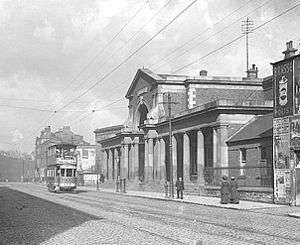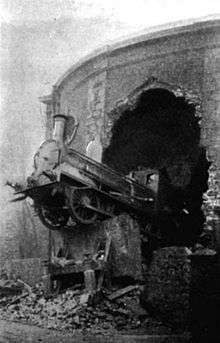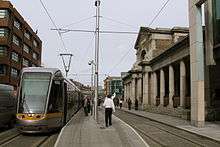Harcourt Street station
Harcourt Street railway station is a former railway terminus in Dublin. The station opened in 1859 and served as the terminus of the line from Dublin to Bray in County Wicklow. It closed in 1958. There is currently a Luas tram stop outside the front of the old station.
 The facade of Harcourt Street station, 1910 | |||||||||||||||||||||||
| Location | Dublin Ireland | ||||||||||||||||||||||
| Coordinates | 53.3334550°N 6.2624722°W | ||||||||||||||||||||||
| Owned by | CIÉ Railways Division | ||||||||||||||||||||||
| Operated by | CIÉ Railways Division | ||||||||||||||||||||||
| Platforms | 1 | ||||||||||||||||||||||
| Construction | |||||||||||||||||||||||
| Structure type | At-grade | ||||||||||||||||||||||
| History | |||||||||||||||||||||||
| Electrified | No | ||||||||||||||||||||||
| Original company | Dublin, Wicklow and Wexford Railway | ||||||||||||||||||||||
| Pre-grouping | Dublin and South Eastern Railway | ||||||||||||||||||||||
| Post-grouping | Great Southern Railways | ||||||||||||||||||||||
| Key dates | |||||||||||||||||||||||
| 7 February 1859 | Station opened | ||||||||||||||||||||||
| 31 December 1958 | Station closed | ||||||||||||||||||||||
| 30 June 2004 | Luas Green Line stop opens outside station building | ||||||||||||||||||||||
| |||||||||||||||||||||||
Harcourt Street Line | |||||||||||||||||||||||||||||||||||||||||||||||||||||||||||||||||||||||||||||||||||||||||||||||||||||||||||||||||||||||||||||||||||||||||||||||||||||||||||||||||||||||||||||||||||||||||||||||||||||||||||||||||||||||||||||||||||||||||||||||||||||||||||||||||||||||||
|---|---|---|---|---|---|---|---|---|---|---|---|---|---|---|---|---|---|---|---|---|---|---|---|---|---|---|---|---|---|---|---|---|---|---|---|---|---|---|---|---|---|---|---|---|---|---|---|---|---|---|---|---|---|---|---|---|---|---|---|---|---|---|---|---|---|---|---|---|---|---|---|---|---|---|---|---|---|---|---|---|---|---|---|---|---|---|---|---|---|---|---|---|---|---|---|---|---|---|---|---|---|---|---|---|---|---|---|---|---|---|---|---|---|---|---|---|---|---|---|---|---|---|---|---|---|---|---|---|---|---|---|---|---|---|---|---|---|---|---|---|---|---|---|---|---|---|---|---|---|---|---|---|---|---|---|---|---|---|---|---|---|---|---|---|---|---|---|---|---|---|---|---|---|---|---|---|---|---|---|---|---|---|---|---|---|---|---|---|---|---|---|---|---|---|---|---|---|---|---|---|---|---|---|---|---|---|---|---|---|---|---|---|---|---|---|---|---|---|---|---|---|---|---|---|---|---|---|---|---|---|---|---|---|---|---|---|---|---|---|---|---|---|---|---|---|---|---|---|---|---|---|---|---|---|---|---|---|---|---|---|---|---|---|---|---|
| |||||||||||||||||||||||||||||||||||||||||||||||||||||||||||||||||||||||||||||||||||||||||||||||||||||||||||||||||||||||||||||||||||||||||||||||||||||||||||||||||||||||||||||||||||||||||||||||||||||||||||||||||||||||||||||||||||||||||||||||||||||||||||||||||||||||||
Luas Green Line | ||||||||||||||||||||||||||||||||||||||||||||||||||||||||||||||||||||||||||||||||||||||||||||||||||||||||||||||||||||||||||||||||||||||||||||||||||||||||||||||||||||||||||||||||||||||||||||||||||||||||||||||||||||||||||||||||||||||||||||||||||||||||||||||||||||||||||||||||||||||||||||||||||||||||||||||||||||||||||||||||||||||||||||||||||||||||||||||||||||||||||||
|---|---|---|---|---|---|---|---|---|---|---|---|---|---|---|---|---|---|---|---|---|---|---|---|---|---|---|---|---|---|---|---|---|---|---|---|---|---|---|---|---|---|---|---|---|---|---|---|---|---|---|---|---|---|---|---|---|---|---|---|---|---|---|---|---|---|---|---|---|---|---|---|---|---|---|---|---|---|---|---|---|---|---|---|---|---|---|---|---|---|---|---|---|---|---|---|---|---|---|---|---|---|---|---|---|---|---|---|---|---|---|---|---|---|---|---|---|---|---|---|---|---|---|---|---|---|---|---|---|---|---|---|---|---|---|---|---|---|---|---|---|---|---|---|---|---|---|---|---|---|---|---|---|---|---|---|---|---|---|---|---|---|---|---|---|---|---|---|---|---|---|---|---|---|---|---|---|---|---|---|---|---|---|---|---|---|---|---|---|---|---|---|---|---|---|---|---|---|---|---|---|---|---|---|---|---|---|---|---|---|---|---|---|---|---|---|---|---|---|---|---|---|---|---|---|---|---|---|---|---|---|---|---|---|---|---|---|---|---|---|---|---|---|---|---|---|---|---|---|---|---|---|---|---|---|---|---|---|---|---|---|---|---|---|---|---|---|---|---|---|---|---|---|---|---|---|---|---|---|---|---|---|---|---|---|---|---|---|---|---|---|---|---|---|---|---|---|---|---|---|---|---|---|---|---|---|---|---|---|---|---|---|---|---|---|---|---|---|---|---|---|---|---|---|---|---|---|---|---|---|---|---|---|---|---|---|---|---|---|---|---|---|---|---|---|---|---|---|---|---|---|---|---|---|---|---|---|---|---|---|---|---|---|---|---|
| ||||||||||||||||||||||||||||||||||||||||||||||||||||||||||||||||||||||||||||||||||||||||||||||||||||||||||||||||||||||||||||||||||||||||||||||||||||||||||||||||||||||||||||||||||||||||||||||||||||||||||||||||||||||||||||||||||||||||||||||||||||||||||||||||||||||||||||||||||||||||||||||||||||||||||||||||||||||||||||||||||||||||||||||||||||||||||||||||||||||||||||
History
The stationed opened on 7 February 1859, after the initial opening of the railway line itself.[1]
The station facade was designed by George Wilkinson, and contains a central arch and a colonnade of doric columns. The station was constructed on an embankment, with the line 25 feet above street level and a Gilbey's bonded spirits store in the undercroft.[2]
Although the line was double track, the station only had a single 597-foot-long (182 m) platform on the west side of the railway, which terminated in a 48'-diameter (14.6 m) turntable at the Hatch Street end of the station. There were two through sidings on the east side of the station, beyond which lay Harcourt Street goods station and the D&WR's locomotive shed. There was no direct access for arriving trains to the goods station, instead 'Up' Freight trains had to pull into the passenger station, then set back onto the 'Down' line before entering the goods station. This was a contributory factor to the 1900 train crash.[3]
The first signal box was installed in 1878, and was replaced with an electro-mechanical installation in 1938 at which point the station was re-signalled with colour light signals.
The station is perhaps most famous for a train crash in 1900 - a cattle train from Enniscorthy failed to stop and crashed through the end wall of the station, leaving the locomotive suspended over Hatch Street. Nobody was killed, though the driver, William Hyland, had his right arm amputated. The locomotive was lowered down onto the existing DUTC tramway and moved to Harcourt Rd., then by temporary track up the goods entrance (modern Harcourt Court) to the station.
Following the accident, the Board of Trade recommended the installation of a facing junction to allow direct access to the goods line, and until that took place all trains were to stop at Ranelagh to ensure that they made a controlled approach to Harcourt Street station.[4] This practice continued up to its closure.
After the formation of The Great Southern Railways in 1925, Harcourt Street gradually declined in importance as services to the South East were increasingly concentrated on Westland Row (now Pearse) station with goods facilities transferred to the North Wall goods station. Thereafter, apart from during the 1933 GNR(I) strike, Harcourt Street became predominately a passenger station. The station continued operating until 31 December 1958, when Córas Iompair Éireann, during its rationalisation programme of the railway network, closed the line from Harcourt Street.
The Luas light rail network that opened on 30 June 2004 utilised parts of the old route. The station building has been converted into a leisure venue with bars and music venues.[5]
Liquor museum
In 1958, C.I.É. opened a liquor museum in the station basement.[6] The exit was to the station refreshment room which was, unlike most other local licensed premises, permitted to sell alcohol in the holy hour between 2pm and 3pm if customers held tickets for distances over 12 miles, namely Bray and beyond.[7] After closure, the museum was moved to the basement of Heuston Station in 1961.[6]
Gallery
.jpg) Last train before closure 31 December 1958
Last train before closure 31 December 1958.jpg) After closure in January 1959
After closure in January 1959 The Harcourt Street train crash, 1900
The Harcourt Street train crash, 1900 Harcourt Luas stop
Harcourt Luas stop
See also
References
| Wikimedia Commons has media related to Harcourt Street railway station. |
- Harcourt Street Archived 2009-03-17 at the Wayback Machine - eiretrains.com
- Harcourt Street station Archived 2006-03-20 at Archive.today - Archiseek
- "BOT Accident Report" (PDF).
- News Archived 2011-09-27 at the Wayback Machine, Number 32, Summer 2008, National Library of Ireland
- "The POD". Archived from the original on 2004-09-17. Retrieved 2009-02-13.
- "Dublin's Liquor Museum". RTE archives. Archived from the original on 19 March 2019. Retrieved 23 March 2019.
- Mac Aongusa, Brian (2003). The Harcourt Street Line - Back on Track. Curragh Press. ISBN 1-85607-907-4.